Best Places to Visit in Jaipur
Jaipur is very popular for its Tourist Attractions. There is a never ending list for Tourist Attractions in Jaipur, Rajasthan. You will find so many Tourist Attractions in Jaipur. These are the center of attractions of Jaipur that makes Jaipur as one of the top tourist cities of India.
City Palace
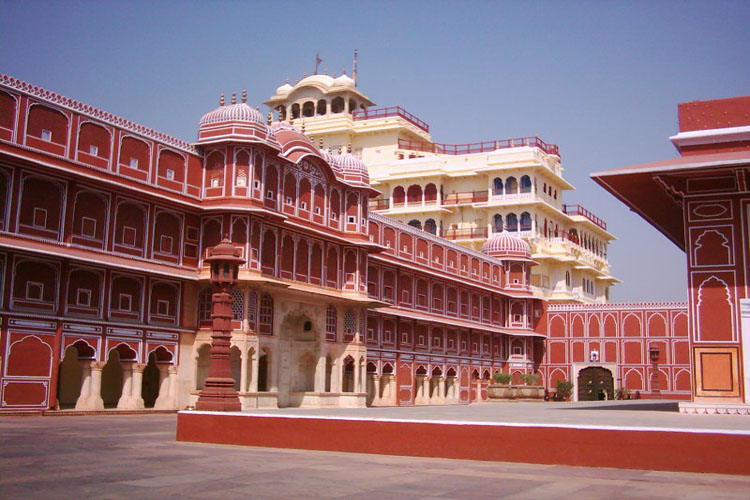
City Palace is an enormous palace complex housing two palaces Chandra Mahal and Mubarak Mahal within the premises. This Palace complex is built in the heart of the city. The palace was from where the Maharaja of Jaipur ruled his province. He was the king of the Kachwaha Rajput clan. The edifice was built sometime between 1729 and 1732 by Sawai Jai Singh II and then the building had undergone so many works till date to look what it is now.
City Place has wonderful gardens, courtyards and building within the premises. Credit goes to the chief architect, Vidyadhar Bhattacharya for producing a splendid architectural monument. Apart from the museums and other attractions inside the Palace, a larger part of it is used by the royal residence. The Palace has a tremendous history behind it.
It was Maharaja Sawai Jai Singh II who laid the huge walls of the palace and initiated his construction. The site was located 11kms from Amber, then capital of his state. Some critical issues forced him to change his capital to Jaipur. He died in 1744 and following that the region witnessed severe wars amidst the Rajput King. Maharaja Ram Singh with the help of British acquired throne and he was the one who commissioned to repaint the while building with Pink to facilitate Prince of Wales. After this color scheme choice of Maharaja, the city was known as the Pink City.
The Mahal is constructed with numerous structures within the premises and each one has different style of architecture. There are multi-storied buildings and gardens that decorate the whole campus. The various structures inside the City Palace include Mubarak Mahal, Chandra Mahal, Pitam Niwas Chowk, Diwan-I-Khas, Diwan-I-Aam, Maharani Palace, Bhaggi Khana and Govind Dev Ji temple.
There are numerous entry gates at this Palace. The entry gates of the city palace are Virendra Pol, Udai Pol near Jaleb chowk and the Tripolia Gate. Udai Pol is also called Atish Pol. Tourists visit this palace are allowed entries only through Virendra Pol and Udai Pol. Tripolia Pol is restricted access as it is used by the Royal Residence of the Palace.
The Palace houses a museum with collections of many artifacts, ancient things and portraits of then rulers. The gates of the palaces are also luxuriously built. City Palace is a multiple structure palace that cannot be missed.
Jal Mahal
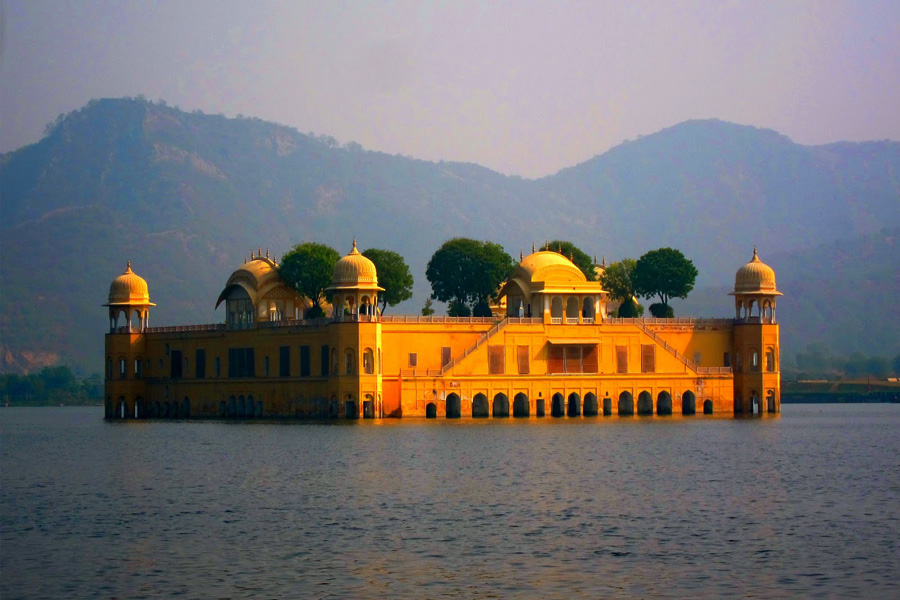
Jai Singh II of Amber has played a noteworthy role in renovating this site. This site Jal Mahal means “Water Palace”. The palace is built in the center of the Lake Man Sagar. But Jal Mahal was deserted until 2001, because the building was not well maintained and hardly attracted tourists. Moreover the lake surrounding the palace also got polluted due to the wastage that flowed into the river from the city Jaipur.
Government took action in collaboration with a private company for the maintenance of the lake, because Jal Mahal remains to account for most of the tourist attraction.
The architecture applied to build this structure brings forth the typical Hindu style. The feature is more depicted by the semi-octagonal towers that mounts elegant cupola. But gradually the works and the plaster used in the walls were losing its credibility and started tearing down in its quality. A special crew of architects joining with the Rajasthan government took over the restoration works to attain what the building is now.
The Mahal also had beautiful garden in its terrace which does not exist now. The current roof top garden was design and commissioned lately few years back during the restoration process. One another attraction around Jal Mahal is located to the opposite of the lake known as Gaitore. They are cenatophs built in remembrance of the Jaipur rulers, just above their cremated platforms. The best cenotaphs amidst them is the dome shaped cenotaphs of Raja Jai Singh II with splendid marble carvings and 20 carved pillars.
- Also Read: Top 10 Historical Places in Rajasthan
Hawa Mahal
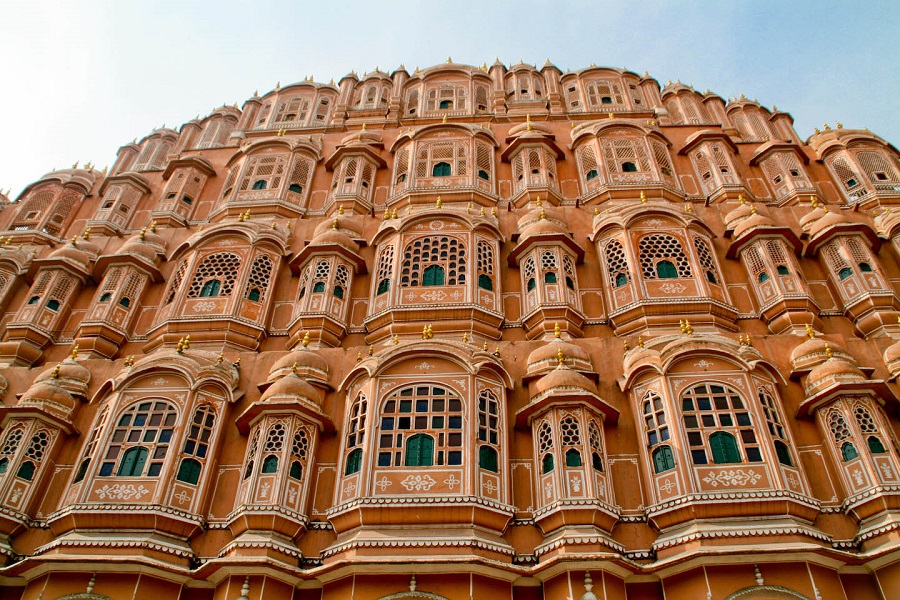
Hawa Mahal is a wonderful place to visit which is positioned within the premises of the city palace. The five storied building is a pleasure to watch during the sunrise; the golden rays illuminate the structure. The Mahal is also called the “Palace of Winds”.
The architecture of this Mahal looks like a beehive with portholes. Something to be noted is this honeycomb like structure has 953 small windows, known as the Jharokhas.
The pyramid shaped edifice was built with due love to Lord Krishna. Architect Lal Chand Ustad designed the Mahal to look alike the crown of Lord Krishna. It was the king of Kachwaha clan, Maharaja Sawai Jai Singh who drafted the initial plan of the building. But his grandson, Sawai Pratap Singh extended the Royal City Palace by building this structure in 1799.
Pratap Singh was an ardent devotee of Lord Krishna and so he dedicated this temple to Krishna, which resembles Mukuta (Krishna’s head gear).
Jharokhas, the 953 small windows are the ones which make the Mahal unique from the other buildings. These windows have an interesting reason behind its construction. The Rajput Royal families were very particular of the Purdah culture, preventing them to be seen by men. The windows were designed and built for the Royal Women to witness daily life of the city streets, festivals, royal processions, etc. Royal Women would stand beyond this artistic Royal Mahal to observe the city.
This site was also used by the Royal family as centre of retreat during hot summers. The window curtains are thus made to allow the required cool breeze. This 50 feet tall monument is a huge structure of semi-octagonal bays. All the five floors of the building are significant and stand unique in its architecture. The rooms have luxurious interiors, decorated with colored marbles with a fountain at the courtyard’s center.
With the Imperial Door opening onto Hawa Mahal, it also has two storied buildings on three sides. It also houses a museum in the courtyard. One can witness a huge courtyard after entering through the Imperial Door. The courtyard also contained a beautiful fountain. Fountains were also built in each of the chambers to obtain the cooling effect from the breeze during summer.
The avenues next to the Mahal, Thar Desert and the Amber Fort are other attractions surrounding Hawa Mahal.
Amber Fort
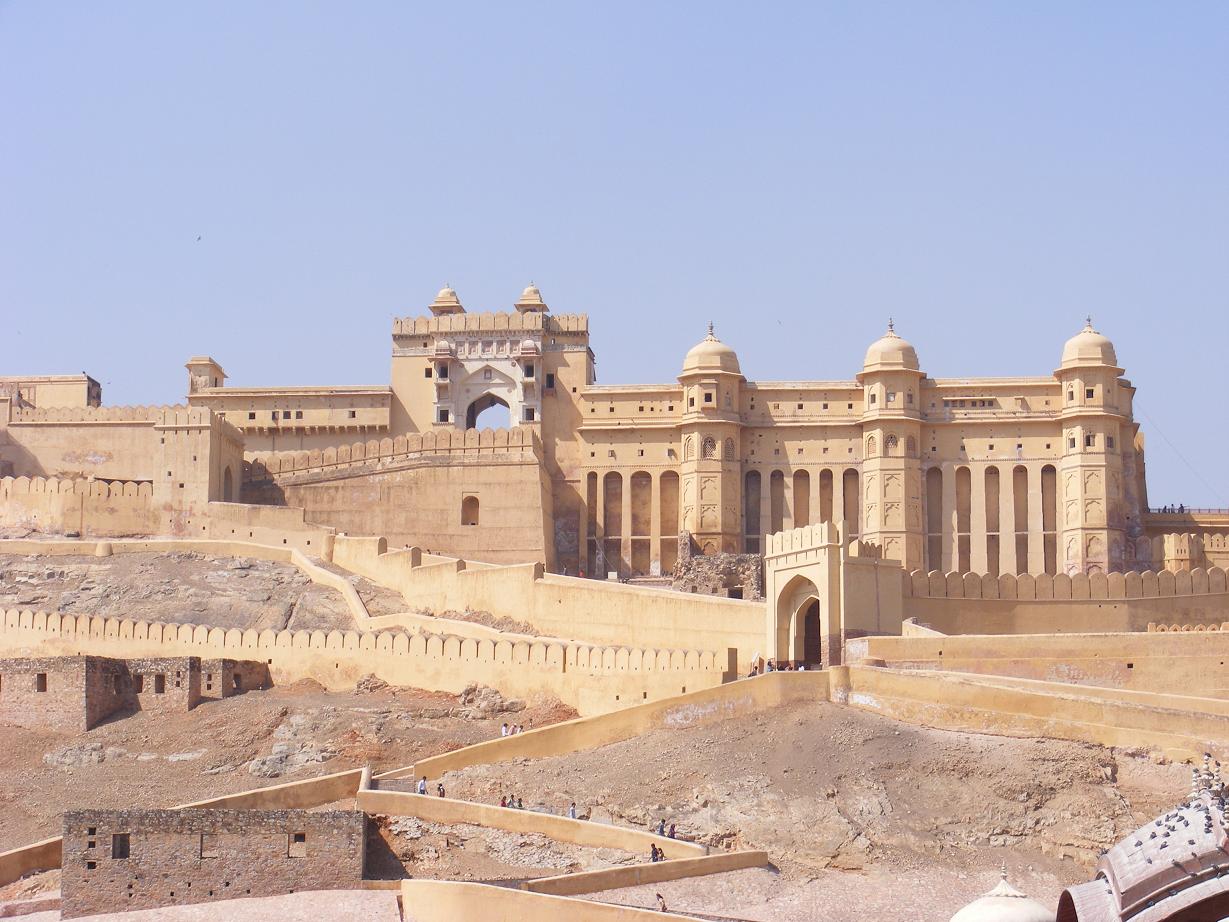
Jaipur is the capital of the state and the city contains some beautiful architecture of Rajputs. One of the flamboyant architectures of Rajputs is the Amber Fort. The city Amber is located 11kms away from Jaipur, the present capital of Rajasthan. The fort is situated on the banks of the Lake Maota and belonged to the ancient rulers of the Kachhawaha clan.
The structure involves Rajput architecture with an incredible art work in the fort. This place has been the major tourist spot in Rajasthan for its historical importance and spectacular art.
The structure that is present today was first commissioned by the commander in chief of Akbar’s army, Raja Man Singh. He built this fort in 1592 from the bits and pieces of the existing fort which were laid by the Meenas. Meenas build this fort and dedicated to their Goddess Amba, who was believed to be the “Queen of the Passes”. The primary part of the fort was completed by Jai Sing I, heir to throne of Raja Man Singh. However the fort underwent repairs and modifications for 150 years till it came under the Kachhawa rule.
Amber Fort is a part of the Jaigarh Fort which is built above the Amber. Both these forts are connected through some equipped passages, and revealed the richness of the Kachhawa clan. Like the Jaigarh fort, the Amber fort is also built with marbles and white & red sandstone. This fort reveals the typical Rajput style of architecture.
The Fort looks rugged and appears as a building of powerful defense, but the interior of the fort is astonishingly lavish. The interior walls are decorated with murals, frescoes, and paintings. Some of these paintings depict the routine of people who lived centuries back. One can also witness mosaic and mirror works on some of these walls. Amber fort comprises four major sections and all these sections are connected by a staircase.
The main entrance leading to the main courtyard Jaleb Chowk is known as Surajpol. There is also a pathway that links all the four sections and tourists are taken in elephants to reach this place. One another major attraction of this place is the Shila Devi Temple dedicated to Goddess Kali, which is famous for its huge silver lions. Amber Fort, an architectural beauty to witness.
Central Museum in Jaipur
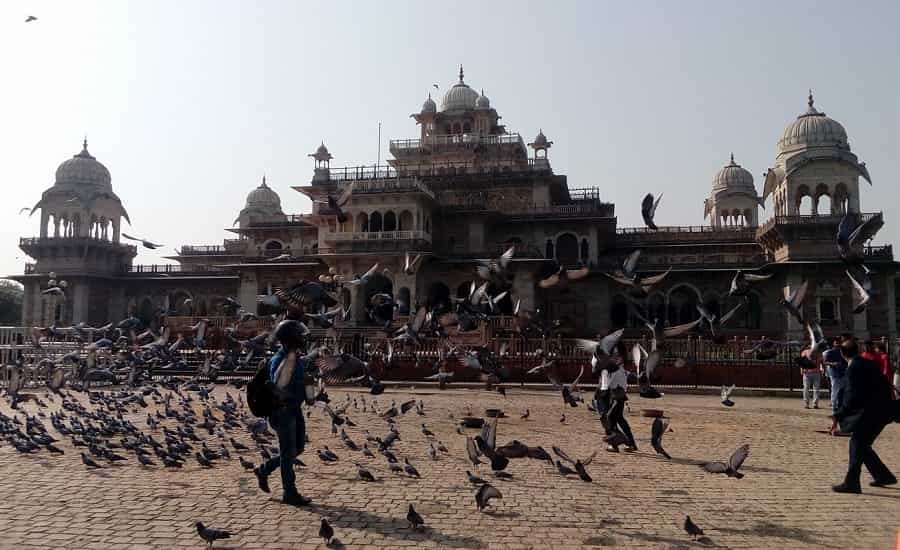
Pic: Lalitha
Rajasthan is one of the prominent tourist spots of the nation and attracts the largest population of tourists every month. The forts, lakes, desert and the artistic Rajput architecture stands a factor for the huge turnaround of tourist population. This city is significant for its cultural and traditional heritage and Central Museum is one such tourist location that brings for the Rajasthani Culture to the people in and around India and also around the world.
Central Museum is one of the oldest museums in India and the oldest in Jaipur and is located in Ram Niwas Gardens. British Army officer, Lt. Swinton Jacob supervised the construction of this building during his term, in 1876. The museum is also known as Albert Museum or the Government Central museum. The Maharaj of Jaipur during this time, Maharaja Ram Singh commissioned this building to be a town hall; but Madho Singh, his successor transformed this structure into an art museum.
Rajasthan is the land which has treasured and possesses many Maharanis and Maharajas. Jaipur has many museums and Central museum is one which treasures an assortment of antiques. These antiques at the museum leave one awe-struck. All the ancient pieces kept here, takes people to travel into the past. It is not only the objects that account for its historical importance, but the building itself is an astonishing piece of art. Indo- Saracenic style is applied in the architecture of this building.
One can witness a rare collection of antique items that were used by the Royal families, couple of centuries back. The museum houses ceremonial dresses that were used by the Royal family and also displays rare wooden work collections of those days. The interior of the museum has many pillars and courtyards with arches that add beauty to this building.
The top deck of the building contains portraits of the rulers and ancient land of Jaipur. This museum also houses a variety of brass works that speaks volumes about the tremendous skill of the persons who carved it to perfection. It also has abundant collections of Jewelry, sculpture and metal works. The museum is open to public until 4 30 PM, starting at 10 30 AM every day.
Rambagh Palace
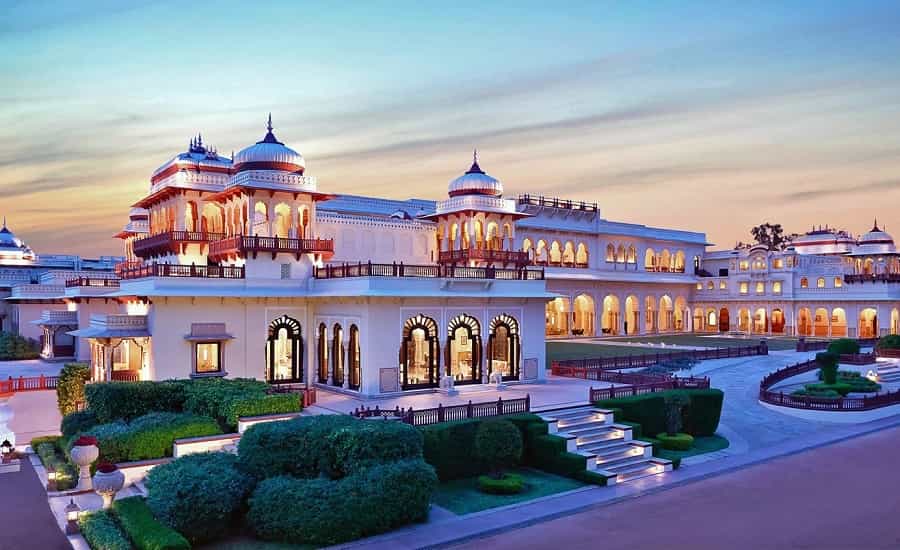
Rambagh palace is one of the reputed hotel groups now, which was a royal residence of the King of Jaipur earlier. Jaipur attracts a lot of tourists round the year for its excellent artistic buildings, forts, and avenue and of course the Thar Desert. How nice it would be to stay in this luxuriously flamboyant city of artistic buildings with a feel of staying at a palace? Rambagh Hotel provides with a numerous facility to make the short stint, a pleasurable memory.
The former residence of the Jaipur king is located 8kms away from the city border. It is transformed into Taj Palace Hotel which is situated on the Bhawani Singh Road. The building at respective time intervals have undergone transformations and it’s an interesting history itself.
Initially this structure was raised as a garden house for the cross nurse of prince Ram Singh II. This initial structure which was built in 1835 was then transformed into a royal hunting lodge by Maharaja Sawai Madho Singh during his period of reign in 1887. The major reason for converting the building into a hunting lodge was because the site was located amidst dense forests. Then later in the early 20th century, Sir Samuel Swinton Jacob designed an expansion to the building making it a royal palace for the kings. Following which Maharajah Sawai Man Singh II chose this to be his royal residence.
This residence was converted into hotel in the mid 20th century, when the 47 acres of vast spread gardens started eating money on maintenance. The other attraction to this location is the Lilypool that is located in the vicinity of Rambagh Palace. Lilypool was once clubbed with the Palace area. Refurbishment of Lilypool happened once in order to have the building as the private residence of the Royals, and after a decade the king passed away. The architecture of this building involves European style.
The Palace hotel offers extravagant services to the people who stay here. A tourist would get all the required amenities within. Restaurants here specialize in Chinese continental, Indian and Rajasthan cuisines. The ambience of the Taj Palace hotel is the best in the city and rest assured is a wonderful stay in Jaipur.
Well Explained Keep it up.